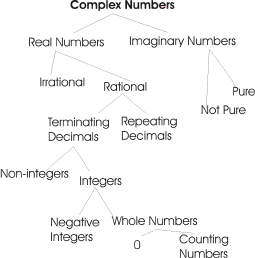
Imaginary Numbers
Imaginary numbers are one of the two sets that make up complex numbers.

Imaginary numbers are written using the variable i. The
basic rule is:
i = √-1
Now using i, you can write the square roots of negative numbers. First, you must review a principle of square roots.
√a√b = √ab
This way, if you are trying to find √-7, you can write it was √-1√7, since -1*7=-7
You know now that √-1 = i, so √-7 = i√7. The i is usually written before a radical it is multiplied by (unlike most variables, which come after their coefficients) to avoid confusion between √7i and √7i.
√-64 = √-1√64 = 8i
Sometimes it takes longer to simplify one of these. For example, √-20.
√-20 = √-1√20 = i√20
However, √20 is not simplified completely.
√20 = √4√5 = 2√5 (Remember? You must factor it into its largest perfect square factor and the other factor with it, then simplify the square root of the perfect square.)
So √-20 = 2i√5.
------
Here's an interesting pattern with imaginary numbers:
i1 = √-1
i2 = √-1√-1 = -1
i3 = -1√-1 = -i or
-√-1
i4 = 1
i5 = 1√-1 = √-1
...
As you can see, the pattern will repeat. Therefore, you can simplify any power of i by dividing the exponent by 4, then taking the remainder and using the value of i with that exponent.
i25 = i because
25/4 = 6 remainder 1, and i1 = 1
i31 = -i
i800 = 1
i802 = -1
Click Here to go to the
next page of imaginary numbers (working with them).
Click Here to go back
to the index.